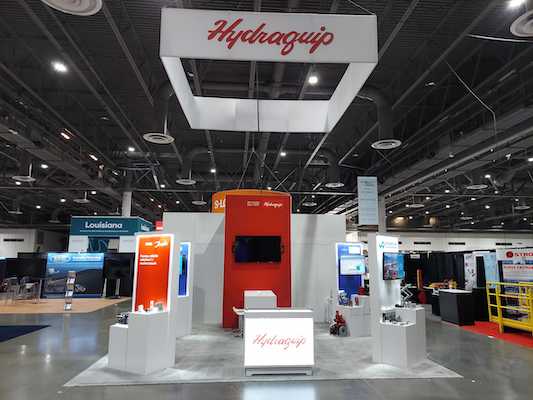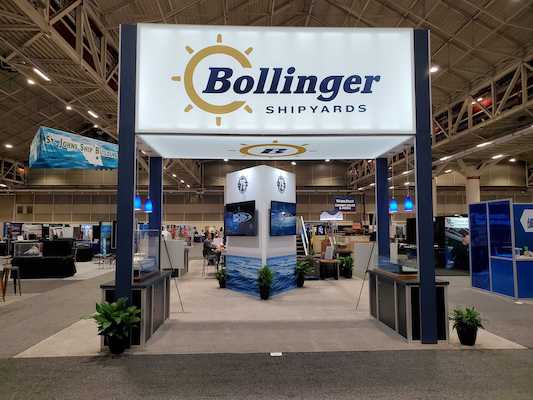If you’re hoping to exhibit at multiple trade shows in a given year, or you want to get more involved in your industry’s trade show circuit, you’ll want to develop a trade show business plan. Also known as a “program,” a trade show business plan involves creating plans and strategies for exhibiting at multiple trade shows and conferences over a period of time. Programming is all about finding ways to ensure that you stay organized, intentional, and prepared throughout your exhibition experience.
Here are 8 key tips to developing an effective trade show business plan:
- Plan Your Budget
- Set Your Goals Early
- Do Research on Shows and Exhibitor Requirements
- Put Together Your Dream Team
- Order Materials and Book Exhibit Space
- Make a Before, During, and After Plan
- Pack Smarter, Not Harder
- Manage Your Booth Logistics
Trade shows are an essential opportunity for businesses to show off their products, advertise their services, and make vital network connections. Planning ahead for your exhibit appearances—even up to a year in advance—gives your business ample time to set objectives and develop strategies to make the most of your time on the trade show floor.
1. Plan Your Budget
Planning your budget should be the first thing on the agenda for any organization looking to organize their next trade show program. There can be many unexpected costs and challenges associated with bringing your team and show booth to a new location. Getting a head start on the costs you can control will help minimize risk and maximize your spending potential.
Break Down the Costs
Breaking down the cost of your next expo appearance will help you figure out your spending potential in the long run. A brief estimated cost breakdown of an average event appearance is:

- Exhibiting space: 10% of budget
- Staffing and travel: 25% of budget
- Exhibit design: 40% of budget
- Show services and premiums: 25% of budget
Of course, this is subject to your unique circumstances. For example, if you’re reusing the same booth across multiple shows, you may spend less on exhibit design, shipping costs, and storage costs. Or if you’re exhibiting close to home, you might not need to spend as much on staffing, transportation, lodging, or meals.
Once you have your budget broken down, your decisions regarding your trade show business plan will become infinitely more efficient and cost effective. If you’re looking for even more tips, check out our blog post about trade booth design on a budget or use our trade show budget template.
Plan for Multiple Shows
Is your team planning on exhibiting at multiple trade shows in a short time period? If so, you should plan ahead and use this to your advantage.
- Consider your exhibit itself. Think about the size and dimensions you’re allotted for your upcoming trade shows. With these in mind, you should seek to rent a trade show booth that can be used for multiple shows. This will save you large amounts of money on design, construction, and other fees.
- Optimize your shipping. Shipping can quickly become more costly than you expect. To reduce this cost, plan your shipping and logistics to be as streamlined as possible. Try to ship your materials directly from one trade show to the next, rather than back to your business or a warehouse. Not only will this cut back on storage costs, but it also significantly reduces your shipping time and costs.
- Use variable branding. If you’re going to multiple trade shows, chances are that they won’t represent the exact same subject matter, culture, and attendee demographic. But rather than making completely separate exhibit designs and branded materials for each show, consider which designs can be kept the same and which should be customized to each event. When possible, prioritize the designs that will remain the same in more prominent areas of your exhibit that are harder to switch out. That way, you can make the most of your designs while streamlining the process to swap out any custom elements.
2. Set Goals Early & Develop Strategies
Before officially registering for any given trade show or convention, you’ll want to determine the goals you most want to achieve as an exhibitor. There are a few questions you may want to reflect on when setting your exhibition goals:
- How will exhibition opportunities best serve your overall marketing plan?
- Are there any areas of emphasis you want to focus on as an exhibitor? (For example, product sales, networking, etc.) What metrics will help you best track your goals?
- What exhibiting environments are most popular or available within your industry? (For example, trade shows, professional association conventions, etc.) How might each potential show environment serve your business?
- How does exhibiting factor into your business or marketing budget?
Setting these objectives in advance helps businesses develop realistic budgets, determine achievable goals, and create clearer strategies for trade show success. By stating these expectations outright, your team will have a better understanding of what they hope to achieve during the show and why it is so important to the company. You can also have a plan in place for how to measure trade show effectiveness and ROI before, during, and after a show.
3. Do Research on Shows and Exhibitor Requirements

Creating a robust trade show business plan requires you to research the shows you’re most interested in participating in. Determine the timing and geographic distance between each show to help you decide which shows you could easily attend, and which you may need to miss.
You’ll also want to know what each specific trade show or convention requires in terms of booth sizing and shipping, exhibitor deadlines, and venue regulations. Each show has its own policy about times for transporting booth displays and materials, and you also want to comply with the venue’s booth size limitations. You don’t want to order a booth that is too big, or have your display arrive late.
Once you understand the exhibition requirements of your intended shows and venue, you can adapt your trade show business plan to those expectations. For example, if you want to be able to demonstrate how your products work in real time for exhibit attendees, you may want to consider your options for larger booth spaces and displays.
4. Put Together Your Dream Team
In-House Staff
Your trade show team can make or break your success at the exhibition, so put together an expo team that showcases the best your business has to offer. Developing a strong, well-prepared exposition team will help your business maintain a consistent presence at trade shows now and into the future.
Before any given show, confirm that your chosen team members will be able to attend the show, and make the travel arrangements ahead of time to save money. When prepping your show team, ensure that your chosen team members are well versed in not just all aspects of your products and services, but also your trade show business plan.
The more closely your employees understand the purposes of your business’ role at this trade show, the better equipped they’ll be to help you meet these objectives and focus on what matters at the expo. It’s best to invest in training for internal staff to make sure they’re well-prepared, since trade show sales are a different skill set than other sales.
Third-Party Staff
There’s more to building your dream team than just your employees. To have a successful exhibit at a trade show, you should consider how much third-party support you’ll need to assist your team to perform their best.
Most businesses will need to outsource the design and build of their booth to professional trade show designers like us. At Cardinal Expo, we also handle all the logistics, shipping, planning, budgeting, and other tasks associated with your booth, taking significant management work off your plate.
You may also want to consider hiring an outside sales team to help handle the influx of visitors you could receive at a trade show. They’ll have the skills needed to attract people at a trade show, but you’ll need to educate them on your products and sales process. It often works best to staff some of your own team members at the booth as well, so the outside sales staff can pass any customers along who require more in-depth knowledge of your company and offerings.
5. Book Exhibit Space and Order Materials
Designing and ordering your trade show displays is one of the most exciting parts of any trade show business plan. However, only order your display materials after finalizing your trade show strategy and finalizing your exhibit space with your trade show. To get your first choice of booth space, try to secure your spot as early as possible.
Your trade show materials can include smaller items like giveaway prizes and promotional merchandise, to your booth display and design features. Designate a lead team member to fill out event registration forms and keep an eye on when space registration times open. Some trade show service partners can help guide you through the paperwork for your show and venue.
6. Make a Before, During, and After Plan
For exhibitors, there are many different stages to a trade show. To keep track of all your teams’ responsibilities during this process, create pre-show, day-of-show, and post-show timelines and checklists for your crew members. Keep regular track of these timelines and checklists to help hold you and your team accountable to your responsibilities, and update these documents whenever any changes are made or items are completed.
To make sure there are no surprises and that every team member knows their designated role, determine who will be working event set-up, out on the floor, and material breakdown. As your team gains more experience in the expo circuit, you might also consider developing trouble-shooting guidelines that outline the best course of action your team has developed for when things don’t go exactly to plan.
7. Pack Smarter, Not Harder
Between product samples, company literature, stands and other organizational elements, and more, it can be easy to overpack. Develop a packing list and plan that clearly outlines the exhibiting materials you’ll be bringing to the show, whether they’ll be shipped or brought in by your team, and any other relevant details.
To make sure your team isn’t rushing to transport materials at the last minute, plan outbound shipping in advance, especially if the show is far out from your location. Many trade shows provide exhibitors with instructions for packing up displays, so familiarize yourself with any materials provided by the expo or venue.
When packing, be sure to avoid overpacking your bags or boxes, since your materials could easily be damaged under the strain. Invest in quality packing materials like padding and bubble wrap to transport delicate or expensive materials. And try your best to leave some additional room in your bags for the trip home—you’ll likely receive a lot of materials during the show, as well.
8. Manage Your Booth Logistics

Shipping a trade show exhibit has more steps to it than a singular package delivery. Additional steps should be taken to ensure everything arrives at the exhibition safely:
- Inform the carrier of unloading deadlines for the trade show, allowing a buffer of time for possible delays.
- Create a detailed list of all items being shipped. Include how many items, boxes, pallets, etc. are included in your shipment.
- Inform the carrier of the total dimensions and weight of the shipment to ensure they have the appropriate accommodations.
- List the trade show, the venue address, and booth number in your shipping description.
- Make sure all parties have a record of move-in and breakdown dates to ensure quick and easy installation and cleanup.
- Consider insuring your exhibit materials. Most carriers will only pay for a small portion of exhibit value if it gets damaged without insurance. Many carriers offer coverage policies, or the business can purchase cargo insurance. All-risk policies ensure the materials are covered on a “all risks”, including external physical loss or damage while in standard transit.
Though it may cost a few extra dollars, paying shipping services to track deliveries is another vital step in reducing stress as a trade show approaches. Tracking helps exhibitors see when packages are in transit, who is transporting them, and where it is delivered.
No Trade Show Business Plan is Complete without Cardinal Expo
Need a hand executing your trade show program? Cardinal Expo can help. We’ve been working in the trade show industry for 28 years and are happy to offer our expertise to exhibiting newcomers and veterans, alike. We offer a variety of trade show services, from booth rentals and custom products to supportive staff to help you from planning to display breakdown. Contact us today to see how we can help you level up your expo experience.
Contact Us Today
We at Cardinal Expo are here to answer any questions you may have, provide you with additional information, and create an effective solution for your exhibit needs.
"*" indicates required fields

